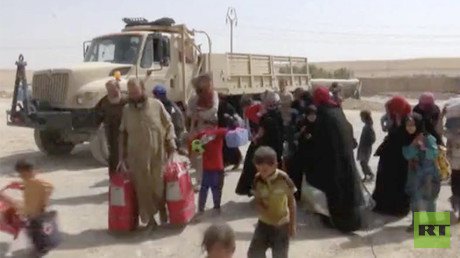Iraqi Army fights for Tal Afar center as displaced locals survive in ‘dire conditions’ (VIDEO)
The Iraqi forces fighting for Tal Afar reported capturing its historic center from Islamic State jihadists on Saturday. People who have fled the violence say they lack basic supplies like water and food in refugee camps and want to go home.
By Saturday, Iraqi forces captured around 70 percent of Tal Afar in northwestern Iraq from Islamic State (IS, formerly ISIS/ISIL), Foreign Minister Ibrahim al-Jaafari announced.
“God willing, the remaining part will be liberated soon,” Jaafari said at a news conference in Baghdad as he was receiving a delegation of French officials.
Iraqi state TV reported on Saturday that the army managed to seize Tal Afar citadel, an Ottoman Empire building in the historic center of the city.
“Units of the Counter-Terrorism Service liberated the Citadel and Basatin districts and raised the Iraqi flag on top of the citadel,” operation commander General Abdulamir Yarallah said.
The elite government forces involved in the offensive, which started on August 20 with US-led coalition support, advanced to the area on Friday, a statement from Iraqi Joint Operations Command (JOC) said.
Tal Afar lies on a supply line connecting former IS stronghold Mosul with the territory it holds in Syria. It had a pre-war population of about 200,000, but the majority of people fled or died, with only 10,000 to 20,000 estimated to remain in the city, according to the US military. The relief group Norwegian Refugee Council gives a higher number, estimating that up to 40,000 civilians may still be in the city after another 30,000 escaped since April.
People, displaced by violence over past few months, are now living in makeshift refugee camps where they suffer from lack of water, food, electricity, medicine, and medical assistance, the UN refugee agency UNHCR said earlier this week. People in the Umm al-Jarabeeh camp told RT's video agency Ruptly they wish to escape the dire conditions they live in and return to their homes.
“There is no electricity, the floor is soil and the roof is nylon, as if we are pickles in a bag,” one resident, Ahmed Ali, told Ruptly.
“There are [water] tanks which come here but they distribute only 4 tanks of 20 liters for 11 people. What can we do with this amount of water? Shall we drink it or use it for washing? Or shall we use it for cooking? It is not enough for the family,” he said, adding that the water the refugees get is contaminated.
“We are in a big trouble, in this hot weather and these tents,” another man said. “I hope if anyone wants to send us to our homes then do it because our houses are liberated and our areas are safe. There is no sense in staying here.”
Earlier this week, two mass graves containing about 500 bodies were found in Badosh on the road between Mosul and Tal Afar, the Iraqi military reported on Friday. The bodies are believed to be victims of IS, killed in 2014 when the jihadist group overran a prison in the area.













